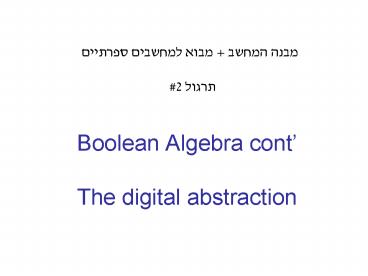Boolean Algebra cont - PowerPoint PPT Presentation
1 / 35
Title:
Boolean Algebra cont
Description:
Idempotent Law. Absorption Law. Commutativity. Absorption Law ... Idempotent Law. Algebra of Sets. Consider a set S. B = all the subsets of S (denoted by P(S) ... – PowerPoint PPT presentation
Number of Views:43
Avg rating:3.0/5.0
Title: Boolean Algebra cont
1
Boolean Algebra contThe digital abstraction
???? ????? ???? ??????? ???????????? 2
2
- Theorem Absorption Law
- For every pair of elements a , b ? B,
- a a b a
- a ( a b ) a
Proof (1)
Identity
Distributivity
Commutativity
Theorem For any a ? B, a 1 1
Identity
(2) duality.
3
- Theorem Associative Law
- In a Boolean algebra, each of the binary
operations ( ) and ( ) is associative. That
is, for every a , b , c ? B, - a ( b c ) ( a b ) c
- a ( b c ) ( a b ) c
4
Proof (1) Let
Distributivity
Commutativity
Distributivity
Distributivity
Idempotent Law
Absorption Law
Absorption Law
5
Commutativity
Distributivity
Distributivity
Idempotent Law
Absorption Law
Commutativity
Absorption Law
6
Same transitions
Putting it all together
before
7
Also,
(2) Duality
8
- Theorem 11 DeMorgans Law
- For every pair of elements a , b ? B,
- ( a b ) a b
- ( a b ) a b
Proof (1) We first prove that (ab) is the
complement of ab. Thus, (ab) ab
By the definition of the complement and its
uniqueness, it suffices to show (i)
(ab)(ab) 1 and (ii) (ab)(ab) 0.
(2) Duality (ab) ab
9
Distributivity
Commutativity
Associativity
a and b are the complements of a and b
respectively
Theorem For any a ? B, a 1 1
Idempotent Law
10
Commutativity
Distributivity
Commutativity
Associativity
Commutativity
a and b are the complements of a and b
respectively
Theorem For any a ? B, a 0 0
Idempotent Law
11
Algebra of Sets
Consider a set S. B all the subsets of S
(denoted by P(S)).
plus ? set-union ? times ? set-intersection n
Additive identity element empty set Ø
Multiplicative identity element the set S.
12
Theorem The algebra of sets is a Boolean
algebra.
Proof By satisfying the axioms of Boolean
algebra
13
A1. Cummutativity of ( ? ) and ( n ).
14
A2. Distributivity of ( ? ) and ( n ).
Let
and
or
or
15
This can be conducted in the same manner as ?. We
present an alternative way
Definition of intersection
Also, definition of intersection
definition of union
Similarly,
16
Taking () and () we get,
Distributivity of union over intersection can be
conducted in the same manner.
17
A3. Existence of additive and multiplicative
identity element.
A4. Existence of the complement.
Algebra of sets is Boolean algebra.
All axioms are satisfied
18
Boolean expression - Recursive definition
base 0 , 1 , a ? B expressions. recursion
step Let E1 and E2 be Boolean expressions.
Then, E1 ( E1 E2 ) ( E1
E2 )
Dual transformation - Recursive definition Dual
expressions ? expressions base 0 ? 1 1 ?
0 a ? a , a ? B\0,1 recursion step Let E1
and E2 be Boolean expressions. Then,
E1 ? dual(E1) ( E1 E2 ) ? dual(E1)
dual(E2) ( E1 E2 ) ? dual(E1)
dual(E2)
19
Let fd be the dual of a function f ( x1 , x2 ,
, xn )
Lemma In switching algebra, fd f ( x1 ,
x2 , , xn )
Proof Let f ( x1 , x2 , , xn ) be a Boolean
expression. We show that applying the complement
on the whole expression together with replacing
each variable by its complement, yields the dual
transformation definition.
Induction basis 0 , 1 expressions.
20
Induction hypothesis Lemma holds for Boolean
expressions E1 and E2 . That is
Induction step show that it is true for E1
( E1 E2 ) ( E1 E2 )
then,
21
If
then,
If
then,
22
Definition A function f is called self-dual
if f fd
Lemma For any function f and any two-valued
variable A, the function g Af Afd is a
self-dual.
Proof (holds for any Boolean algebra)
Dual definition
Distributivity
Commutativity
23
Distributivity
Commutativity
A is the complement of A
Identity
Commutativity
Notice that the above expression has the
form ab ac bc where a A, bf,
c fd.
24
We now prove a stronger claim
Identity
a is the complement of a
Distributivity
Commutativity
Commutativity
Distributivity
Theorem For any a ? B, a 1 1
Identity
25
For example
self-dual
26
Easier proof (1) for switching algebra only
(using dual properties)
Switching algebra
OR
Identity
27
Easier proof (2) for switching algebra only
(case analysis)
A 0
0 1
Identity
Commutativity
Theorem For any a ? B, a 0 0
Absorption Law
Identity
28
A 1
29
Example of a transfer function for an inverter
30
(No Transcript)
31
true only if
32
BUT, this is not always the case. For example
Moreover, in this example it can be proved that
no threshold values exist, which are consistent
with definition 3 from lecture notes.
33
Using the assumption
slope lt -1
34
(No Transcript)
35
slope -1
f (x) x
slope -1
true if
slope lt -1































